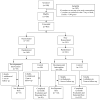Neurodevelopmental outcomes in infants requiring resuscitation in developing countries
- PMID: 22099522
- PMCID: PMC3309169
- DOI: 10.1016/j.jpeds.2011.10.007
Neurodevelopmental outcomes in infants requiring resuscitation in developing countries
Abstract
Objective: To determine whether resuscitation of infants who failed to develop effective breathing at birth increases survivors with neurodevelopmental impairment.
Study design: Infants unresponsive to stimulation who received bag and mask ventilation at birth in a resuscitation trial and infants who did not require any resuscitation were randomized to early neurodevelopmental intervention or control groups. Infants were examined by trained neurodevelopmental evaluators masked to both their resuscitation history and intervention group. The 12-month neurodevelopmental outcome data for both resuscitated and non-resuscitated infants randomized to the control groups are reported.
Results: The study provided no evidence of a difference between the resuscitated infants (n = 86) and the non-resuscitated infants (n = 115) in the percentage of infants at 12 months with a Mental Developmental Index <85 on the Bayley Scales of Infant Development-II (primary outcome; 18% versus 12%; P = .22) and in other neurodevelopmental outcomes.
Conclusions: Most infants who received resuscitation with bag and mask ventilation at birth have 12-month neurodevelopmental outcomes in the reference range. Longer follow-up is needed because of increased risk for neurodevelopmental impairments.
Trial registration: ClinicalTrials.gov NCT00639184.
Copyright © 2012 Mosby, Inc. All rights reserved.
Conflict of interest statement
The authors declare no conflicts of interest.
Figures
References
-
- Lawn JE, Cousens S, Zupan J. 4 million neonatal deaths: When? Where? Why? Lancet. 2005;365:891–900. - PubMed
-
- Al-Macki N, Miller SP, Hall N, Shevell M. The spectrum of abnormal neurologic outcomes subsequent to term intrapartum asphyxia. Pediatr Neurol. 2009;41:399–405. - PubMed
-
- Perlman JM, Risser R. Cardiopulmonary resuscitation in the delivery room. Associated clinical events. Arch Pediatr Adolesc Med. 1995;149:20–25. - PubMed
-
- Singhal N, McMillan DD, Yee WH, Akierman AR, Yee YJ. Evaluation of the effectiveness of the standardized neonatal resusitation program. J Perinatol. 2001;21:388–392. - PubMed


